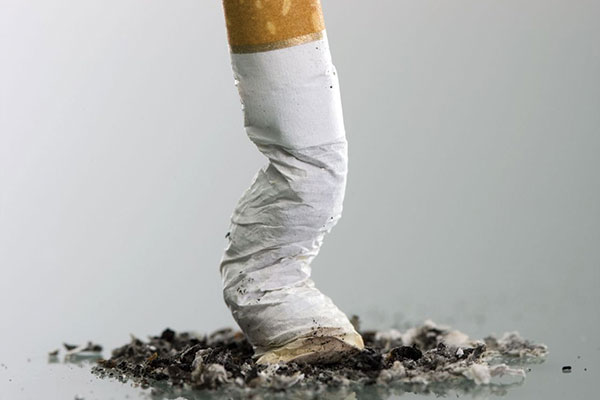Put Down That Cigarette and READ THIS
Steps for Quitting Tobacco after a Cancer Diagnosis
by Donna Richardson, MSW, LCSW, LCADC, CTTS, and Claribel Beltrez
You have cancer. The biopsy and the scan results are back. Some days, you feel like you’re stuck in a bad dream. There are more tests to be done and specialists to see. You’re learning a whole new vocabulary. You’re worried about insurance coverage. Stress is high. And now your doctors are telling you to quit smoking. Easy for them to say.
You want to quit. You’ve been trying to quit. Yesterday, you smoked even more than usual. A voice inside your head says, I can do this. But then another says, Why bother?
Your brother cries, “You have lung cancer and you haven’t quit smoking?! What will it take to make you quit? What is wrong with you?” Your daughter pleads, “Don’t you even care about us? You told me you would quit.” Your best friend – she quit last year – declares, “If I can quit, you can quit.”
But it’s not that simple, is it? Before you throw in the towel, though, here are four things you should know:
- If you’re using tobacco and you have cancer, the science suggests that quitting improves outcomes. Science also tells us that quality of life for people who quit is higher than for those who don’t.
- People quit every day. It’s not easy, but it is possible.
- Resources to help people quit are available in all 50 states.
- The National Comprehensive Cancer Network’s Clinical Practice Guidelines suggest a two-pronged approach to quitting: FDA-approved medications to manage withdrawal, plus support for behavioral change.
Quitting tobacco improves cancer outcomes, and quality of life.
The number of toxins in cigarettes now totals 7,000. Each puff brings these toxic substances into your body. When you quit smoking, you eliminate the intake of 7,000 toxins! One of those toxins, carbon monoxide, directly affects your red blood cells’ capacity to carry and deliver oxygen. Oxygen is the fuel that allows our cells to produce energy. It’s a resource that is especially needed during cancer treatment. In addition, continuing to smoke tobacco after a cancer diagnosis has been shown to decrease quality of life and lessen a person’s sense of wellbeing.
People with cancer and other serious illnesses quit smoking every day.
At the Rutgers Tobacco Dependence Program, we see this firsthand. Rates of smoking have decreased to about 17 percent in New Jersey, where our program is located. Several factors play a part in these lowered rates, including increased awareness of the health risks of smoking, increased expense of tobacco products, availability of medicines to help people quit, increased concern about public smoking, and restrictions on marketing tobacco products.
The number of toxins in cigarettes now totals 7,000. Each puff brings these toxic substances into your body.
We know that receiving a diagnosis of cancer does not make quitting easier. However, we also know that people who have support for behavioral change plus medications to help manage withdrawal symptoms are more likely to quit.
Resources for quitting tobacco are available nationwide.
Every U.S. state has a QuitLine. Calling 1-800-QUIT-NOW links you with the tobacco cessation services of your state. Basic service in each state is funded by the federal government, plus many states provide supplemental funds for ongoing care. Numerous regional cancer centers also offer on-site tobacco treatment services. Some of them even employ certified tobacco treatment specialists, which are healthcare providers who’ve received specialist training in treating tobacco dependency.
Experts recommend a two-pronged approach to quitting tobacco.
The first part of a successful tobacco treatment plan is using medications to manage withdrawal. The U.S. Food and Drug Administration has approved seven medications to treat tobacco addiction:
- nicotine transdermal patch
- nicotine gum
- nicotine lozenges
- nicotine inhaler
- nicotine nasal spray
- bupropion
- varenicline
The purpose of these medications is to treat the withdrawal symptoms a person typically has when decreasing or quitting tobacco use. These include feeling irritable, anxious, disoriented, frustrated, blue, or impatient; fatigue; loss of focus or concentration; and tobacco cravings. Most people find that a combination of several smoking cessation medications works best. However, not all medications are right for everyone. And, even though several are available over the counter, it’s important to work with your healthcare provider to decide which ones are right for you.
The second part of a successful tobacco treatment plan is support for behavioral change. Tobacco use is a learned behavior. And to quit is to rework a big part of your daily routine. Just like Pavlov’s dogs, people who smoke come to associate certain actions, places, or people with tobacco use. For smokers, common activities linked to smoking, like waking up in the morning, driving a car, and finishing a meal, need “unlearning.”
Thoughtful planning and substituting new behaviors for tobacco smoking can help a tobacco user successfully restructure their routines. Support for behavioral change is available through websites, smartphone apps, chat lines or helplines, and more formalized cognitive behavioral therapy offered by mental health professionals in group or individual sessions.
Research shows that this approach – medication to manage withdrawal plus support for changing behavior – is the best way to quit tobacco. But the first step is up to you. You must make it a priority to quit. Not only will you improve your chances of beating cancer, but you’ll also improve the quality of each day that you live.

Donna Richardson (photo, left, by Steve Hockstein), a certified tobacco treatment specialist, is the clinic coordinator for the Tobacco Dependence Program and an instructor at Rutgers School of Public Health in Piscataway, NJ. She has more than 30 years’ experience working with people to change behaviors that no longer work well for them. Every day, she sees someone quit tobacco use, and that makes her very happy.

Claribel Beltrez (photo, right, by Steve Hockstein) coordinates the training and outreach activities of the Rutgers Tobacco Dependence Program, including its Certified Tobacco Treatment Specialist Training and Latino tobacco outreach programs.
No matter where you live, you can visit SmokeFree.gov for more resources and information to help you quit smoking today.
This article was published in Coping® with Cancer magazine, September/October 2017.


